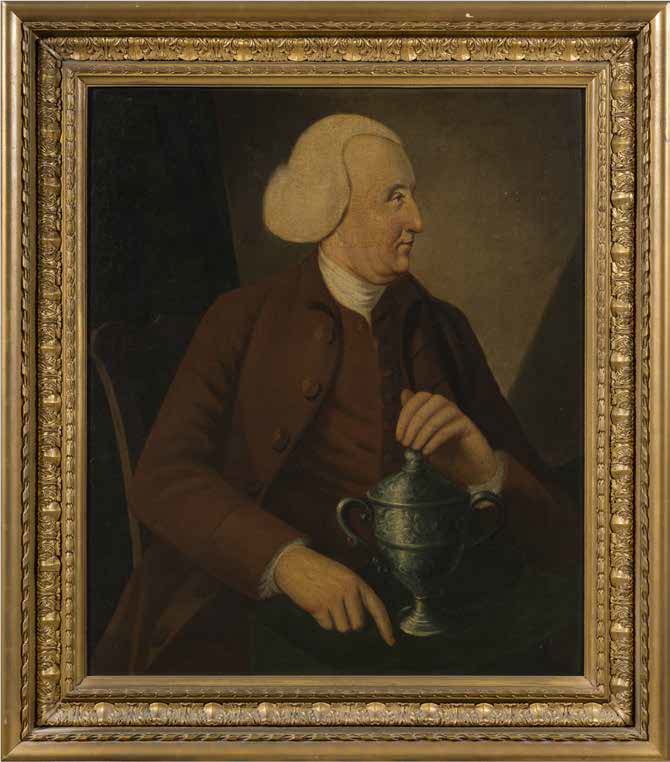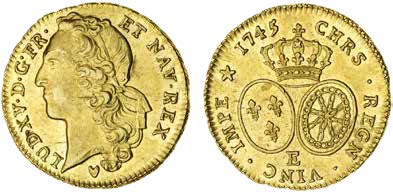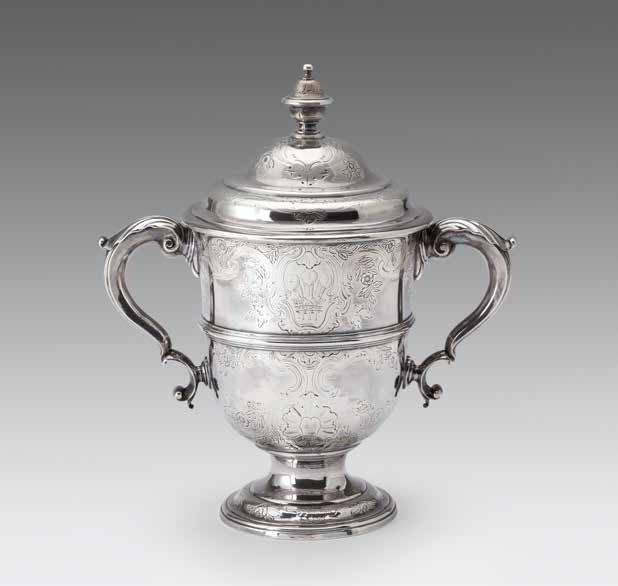
Martyn Downer
THE ENGLISHMAN WHO SAVED THE JACOBITES’ GOLD

While describing how Robert Strange prepared etching plates to print paper money for Prince Charles Edward Stuart to pay his troops as the Jacobite rebellion collapsed in 1746 (Insider, Winter 2019), Jonathan Callaway recalled the mysterious fate of a cache of French gold, landed too late to save the rising but ‘the subject of much entertaining speculation ever since’. The rediscovery of a silver cup has now solved a riddle which has obsessed treasure hunters for centuries. It also sheds important new light on the chaotic aftermath of Culloden when the defeated Jacobites, in hiding across Scotland, were riven by betrayals, suspicions and bitter jealousies.
On 29th April 1746, two weeks after the Battle of Culloden, the French privateer ships Mars and Bellone anchored in Loch nan Uamh at Arisaig on the west coast of Scotland to offload six casks of Louis d’Ors worth about £35,000 (£5 million today). The coins had been shipped by Louis XV of France in support of the Jacobite rebellion. As the rebellion had since collapsed, the casks were buried in several secret locations near Loch Arkaig. The whereabouts of the gold, its safekeeping and distribution, when necessary, to sustain or revive the Jacobite cause, was entrusted to Euan Macpherson of Cluny, chief of the Macpherson Clan, who had served as a colonel in the Jacobite army.
In April 1748, Prince Charles Edward Stuart,
now impoverished and facing expulsion from exile in France, sent coded orders that Cluny should cooperate with Jacobite secret agent ‘Thomas Newton’—identified as Major Kennedy, an Irish officer in French service who had been in the prince’s bodyguard at Culloden—and recover the gold before sending it south to London. (1) From his ‘cage’, a cleverly constructed Highlands hideout, Cluny promised to “raise so many of the cattle (sic) and drive you all I can…Let me know the place of delivery.” (2) Unable to return to Scotland himself for fear of capture, Kennedy travelled to Newcastle where he enlisted the help, possibly through Jacobite Freemason connections, of Northumbrian farmer Charles Selby of Yearl (now Earle) near Wooler.
Charles’s name, taken from two recent Stuart monarchs, betrayed his family’s Jacobite sympathies. A kinsman of the Selbys of Biddlestone, a Catholic family with strong Jacobite ties, his father William Selby (1668-1723) had been ‘out’ in the earlier 1715 rebellion. (3) William Selby’s imprisonment may have caused his early death and radicalised his son as Charles seized this chance to serve the exiled prince, telling Kennedy that “I am sincerely yours to command at any time, & particularly when there is question of anything that regards our Dear friend, whom I should always serve at the expense of my life & fortune.” (4)
“William Selby’s imprisonment may have caused his early death and radicalised his son as Charles seized this chance to serve the exiled prince”
Visiting Yearl, Kennedy was introduced to Cluny’s brother-in-law Donald Macpherson of Breachachie with whom Selby was acquainted. Breachachie and Cluny had both been on the shore of Loch nan Uamh on 19 September 1746 when Prince Charles Edward Stuart, after months on the run, often in disguise, had finally escaped Scotland in a French warship. Identified as ‘D’ in the secret correspondence, Breachachie volunteered to act as the go-between with Cluny and to carry the gold as far as the Scottish border where he would meet Selby. Selby would then stash the gold at his Northumbrian farmhouse before it could be safely delivered to Jacobite agents in London either by Kennedy or, more likely, by Selby himself, as the major had already been arrested once at Newcastle and feared he was being watched. Breachachie would be paid £600 (out of the gold) for his services but Selby refused all payment for risking his life in the prince’s cause. (5)
Satisfied, Kennedy now replied to Cluny’s request for delivery instructions telling him that the “safest & best place of delivery that I can find out is Yearl, a farm house belonging to a thorough gent, a friend of mine & which is less than a small mile to Wooller which is eight miles to the Southward of Kelso. This gent himself will go twenty miles on the Edinburgh road to meet D. who he knows.” (6)
In December 1748, Kennedy reported success in securing some, but not all of the ‘horses’ (no longer ‘cattle’) requested by the prince. (7) Almost a century later, in 1835, it was reported that “an old man, lately deceased” recalled seeing the Highlanders return across the Scottish border after delivering the gold to Yearl. (8) Selby then rode
the gold down to London himself, accompanied only by a trusted servant.
In this way, Selby and Breachachie managed to smuggle £6,000 of the Jacobite gold out of Scotland and down to London in two runs. Kennedy promised another expedition to Scotland in 1749 as: “the jockey I deal with [Selby] is determined to take a tour to that country as soon as he has finished certain affairs”. (9) In fact, it appears no further gold was secured for the prince as Kennedy was arrested in London soon afterwards. After interrogation he managed to escape to France and disappeared. (10)
Although the secret plan to transport the gold over five hundred miles from its hiding place in the Highlands via Yearl in Northumberland and into the hands of Jacobite bankers in London was successful, the treasure had already caused ill-will and resentment among the Jacobites and Highland clans. Both Cluny and Kennedy were accused of misappropriation by rival factions. The prince harboured his own doubts about Cluny and summoned him to France to account for the rest of the treasure, as well as his royal equipage abandoned during the flight from Culloden. Late to the action, Cluny had discovered the prince’s baggage in a deserted wagon near the battlefield. Many belongings had been looted, including the prince’s silver canteen (now Collection of National Museums Scotland) (11); but several items of valuable silver survived, remnants of the courtly lifestyle the prince had tried to project during the rebellion. Safeguarding these precious possessions caused Cluny further anxiety despite the prince’s initial suggestion, when they met after the battle, that, like the French gold, his silver should be used to sustain the Jacobite cause.

Writing from France in 1755, Cluny recalled that “these effects were removed to avoid danger at least fifty different times, and often by different hands in the dark of night, sometimes thrown into falls of water, sometimes into marshes, and sometimes into pits dug on purpose in the ground.” (12) The prince claimed that his equipage had included a casket of jewels but Cluny denied all knowledge of this, further fuelling mistrust between the two men. (13) Meanwhile, the royal silver remained hidden in Scotland and, following Cluny’s death in 1763, it was entrusted to Donald Macpherson of Breachachie who had acted with Charles Selby in smuggling out the ‘Loch Arkaig Treasure’. After repeated requests from the prince in Rome, the remnants of the silver were eventually shipped from Edinburgh in 1765. Pressed by the prince to account for the many missing items, Cluny’s widow and daughter retorted that “they could answer for the plate with their heads” suggesting that, like the French gold, much of the prince’s silver had been distributed to support the Jacobite movement, as Cluny believed he had been instructed after Culloden. (14) It seems a silver cup presented to Charles Selby was one of those items given away by Cluny, possibly on the prince’s order, as Selby had refused all payment for risking his life smuggling the Jacobite gold.
The cup itself was made in 1743 by Paul Crespin (1694-1770), a highly regarded London silversmith of Huguenot ancestry with workshops in Soho. About ten inches high, it is of typical period form with a pedestal foot, two leaf-capped handles and a domed cover with baluster finial. The body of the cup is applied with banding and profusely flat chased with roses, scrolls and rocaille. The use of roses, nationalist symbols of Jacobite re-birth, which also decorated the prince’s silver canteen, suggest that the cup, a traditional object of loyalty, was a bespoke gift to the prince, possibly from a wealthy English sympathiser. It was important for the prince, and his followers, that he should display all the trappings of a court in waiting during the rebellion, and cups had the highest status of all silver objects. Practical and prized, they were used for ceremony and shared as courtly gifts and in diplomatic exchanges.
Amidst the decoration on the front of the cup is a cartouche engraved with the feathers and coronet of the Jacobite prince of Wales; again this closely matches the same royal device on the prince’s canteen captured at Culloden. A cartouche on the reverse has the later inscription:
From
Prince Charles Edwd Stuart
To
Chas Selby Esqr of Earle
in Remembrance of His Many Services in
1745 & 1746
By its styling, it appears this inscription was applied to the cup in the early nineteenth century, probably by Charles Selby’s son
Thomas Selby (1756-1846). For reasons of his own security, Charles Selby’s role in smuggling the Jacobite gold, for which he would undoubtedly have been executed if caught, was kept secret during his lifetime. Nor did Selby mention the silver cup in his will, a legal and therefore public document, although he did have himself painted with his cup in a portrait which displays his obvious pride in his risky venture.
Timeline…
1743: Silver cup made by Paul Crespin for Prince Charles Edward Stuart, Jacobite Prince of Wales.
16th April 1746: Battle of Culloden
29th April 1746: Gold landed by Mars and Bellone at Loch nan Uamh and hidden at Loch Arkaig.
19th September 1746: Prince Charles Edward Stuart escapes to France.
April 1748: In exile, Prince Charles Edward Stuart asks Major Kennedy to recover hidden gold. Major Kennedy, Donald Macpherson of
Breachachie and Charles Selby meet at Yearl in Northumberland.
By December 1748: Gold valued at £6000 smuggled to London by Charles Selby and a servant.
22nd April 1749: Major Kennedy arrested in London and interrogated about the gold.
June 1749: Major Kennedy escapes to France.
August 1749: In Paris, Major Kennedy receives bill of exchange from Jacobite bankers in London for smuggled gold.
31st January 1788: Prince Charles Edward Stuart dies in Rome.
1789: Charles Selby dies.
1835: Story of the cup published for the
first time by Thomas Selby.
1970s: Cup and portrait of Charles Selby seen in Edinburgh.
1998: Cup sold at Christie’s, Glasgow.
23rd October 2000: Cup sold at Christies, New York: Lot 462 ‘A George II Silver Two-Handled Cup and Cover’. Collection of Barbara Wainscott (1947-2018).
31st October 2018: Cup sold at Doyle Auctions, New York: Lot 252, ‘George II
Silver Covered Two Handle Cup’.
Only in 1837 was Charles Selby’s remarkable role in the ’45 finally revealed. With the Jacobite threat long since passed, and the rebellion now seen in romantic terms, the story of the smuggled treasure was published by John Burke in A Genealogical and Heraldic History of the Commoners of Great Britain. In his entry for the Selbys of Earle, submitted by the family, Burke revealed that:
Mr. Selby, in the rising of 1745, sent a man and horse to aid Prince Charles, and himself and servant assisted in conveying a sum of money, in Louis d’or’s from the Highlands to London, in the following year, but for this service, refusing to accept any remuneration, he was complimented with a piece of plate, from the prince then in France. Mr Selby’s youngest, but only surviving, son is the present THOMAS SELBY, esq. of Earle. (15)
The cup then disappeared again until the

still in possession of an unnamed member of the Selby family, it was mentioned by author Nancy Ridley (1911-1986) in A Northumbrian At Large (London, 1975). Ridley had been shown the cup in Edinburgh, together with the portrait of Charles Selby. (16) Separated by a family sale in the 1990s, the cup travelled to America uncoupled from its portrait, with its meaning lost. Sold again in 2018, the cup has since returned to Britain with its history now fully restored. After lengthy research, the portrait of Charles Selby was traced to a family member and is published here for the first time. Together the cup and portrait tell an extraordinary story, and pay tribute to the exceptional bravery and resourcefulness of Northumbrian farmer Charles Selby.
The silver cup belonging to Prince Charles Edward Stuart will be exhibited from 4th May 2020. For further details about its sale and exhibition please contact Tim Robson, [email protected], 0207 563 4007.
Sources:
Primary:
The Stuart Papers, Royal Archives, vols. 295-308
Published:
Burke, J, A Genealogical and Heraldic History of the Landed Gentry (London, 1837)
Corp, E, The Stuarts in Italy, 1719-1766 (Cambridge, 2011)
Francis, GR, Romance of the White Rose: A Jacobite Portrait Gallery, Narrating the Romantic Activities of Principal Characters of the Jacobite Movement (London, 1933)
Gooch, L, The Desperate Faction? The Jacobites of North-East England 1688-1745 (Hull, 1995)
Guthrie, N, The Material Culture of the Jacobites (Cambridge, 2013)
Lang, A, Pickle the spy, or, The incognito of Prince Charles (London, 1897)
The Companions of Pickle. Being a sequel to ‘Pickle the Spy’ (London, 1898)
Macpherson, AG, A day’s march to ruin (Newtonmore, 1996)
McLynn, F, Charles Edward Stuart: A Tragedy in Many Acts (London, 1988)
Miscellany of the Scottish History Society
Riding, J, Jacobites: A New History of the ’45 Rebellion (London, 2015)
Ridley, N, A Northumbrian at Large (London, 1975)
Zimmermann, D, The Jacobite movement in Scotland and in exile, 1746-1759 (Cambridge, 1998)
Martyn Downer is a specialist in historic objects and works of art. He is author of four books including “Nelson’s Purse: The Mystery of Lord Nelson’s Lost Treasures” (2004). martyndowner.com
1 Lang (1897), 67ff.
2 Francis, 323.
3 Gooch, Appendix, 183.
4 Charles Selby to ‘Thomas Newton’ (Major Kennedy), undated [December 1749], Royal Archives [RA], Stuart Papers, 302/56.
5 Macpherson, 186-7.
6 Francis, 323.
7 Major Kennedy to Prince Charles Edward
Stuart, 5 December 1748, RA Stuart Papers, 295/91.
8 The New Statistical Account of Scotland,
Vol. 5 (1835)
9 Major Kennedy to Prince Charles Edward
Stuart, 5 December 1748, RA Stuart Papers, 295/91.
10 Major Kennedy to Prince Charles Edward Stuart, 15 June 1749, RA Stuart Papers, 298/131.
11 See: https://www.nms.ac.uk/ex-plore-our-collections/stories/scottish-histo-ry-and-archaeology/the-jacobite-challenge/the-jacobite-challenge/bonnie-prince-char-lies-travelling-canteen/
12 Miscellany of the Scottish History Society,
Vol. 7 (1941)
13 Miscellany of the Scottish History Society,
Vol. 7 (1941), 161, n.4.
14 Francis, 321.
15 Burke, 706.
16 Ridley, 115.
